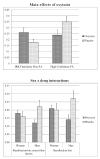Effects of oxytocin on behavioral and ERP measures of recognition memory for own-race and other-race faces in women and men
- PMID: 23648370
- PMCID: PMC3775862
- DOI: 10.1016/j.psyneuen.2013.04.002
Effects of oxytocin on behavioral and ERP measures of recognition memory for own-race and other-race faces in women and men
Abstract
Oxytocin has been shown to affect human social information processing including recognition memory for faces. Here we investigated the neural processes underlying the effect of oxytocin on memorizing own-race and other-race faces in men and women. In a placebo-controlled, double-blind, between-subject study, participants received either oxytocin or placebo before studying own-race and other-race faces. We recorded event-related potentials (ERPs) during both the study and recognition phase to investigate neural correlates of oxytocin's effect on memory encoding, memory retrieval, and perception. Oxytocin increased the accuracy of familiarity judgments in the recognition test. Neural correlates for this effect were found in ERPs related to memory encoding and retrieval but not perception. In contrast to its facilitating effects on familiarity, oxytocin impaired recollection judgments, but in men only. Oxytocin did not differentially affect own-race and other-race faces. This study shows that oxytocin influences memory, but not perceptual processes, in a face recognition task and is the first to reveal sex differences in the effect of oxytocin on face memory. Contrary to recent findings in oxytocin and moral decision making, oxytocin did not preferentially improve memory for own-race faces.
Keywords: ERP; Other-race faces; Own-race faces; Oxytocin; Recognition memory; Remember/know; Sex differences.
Copyright © 2013 Elsevier Ltd. All rights reserved.
Figures




Similar articles
-
Oxytocin eliminates the own-race bias in face recognition memory.Brain Res. 2014 Sep 11;1580:180-7. doi: 10.1016/j.brainres.2013.07.015. Epub 2013 Jul 18. Brain Res. 2014. PMID: 23872107 Free PMC article.
-
Neural correlates of memory encoding and recognition for own-race and other-race faces in an associative-memory task.Brain Res. 2017 Jan 15;1655:194-203. doi: 10.1016/j.brainres.2016.10.028. Epub 2016 Nov 2. Brain Res. 2017. PMID: 27815095
-
The neural correlates of memory encoding and recognition for own-race and other-race faces.Neuropsychologia. 2011 Sep;49(11):3103-15. doi: 10.1016/j.neuropsychologia.2011.07.019. Epub 2011 Jul 23. Neuropsychologia. 2011. PMID: 21807008
-
Event-related brain potential correlates of the other-race effect: A review.Br J Psychol. 2023 May;114 Suppl 1:24-44. doi: 10.1111/bjop.12591. Epub 2022 Aug 26. Br J Psychol. 2023. PMID: 36018312 Review.
-
Neural timing of the other-race effect across the lifespan: A review.Psychophysiology. 2023 Apr;60(4):e14203. doi: 10.1111/psyp.14203. Epub 2022 Nov 13. Psychophysiology. 2023. PMID: 36371686 Review.
Cited by
-
Dog-Owner Attachment Is Associated With Oxytocin Receptor Gene Polymorphisms in Both Parties. A Comparative Study on Austrian and Hungarian Border Collies.Front Psychol. 2018 Apr 5;9:435. doi: 10.3389/fpsyg.2018.00435. eCollection 2018. Front Psychol. 2018. PMID: 29674985 Free PMC article.
-
Oxytocin facilitates social approach behavior in women.Front Behav Neurosci. 2014 May 27;8:191. doi: 10.3389/fnbeh.2014.00191. eCollection 2014. Front Behav Neurosci. 2014. PMID: 24904342 Free PMC article.
-
Endogenous oxytocin, cortisol, and testosterone in response to group singing.Horm Behav. 2022 Mar;139:105105. doi: 10.1016/j.yhbeh.2021.105105. Epub 2022 Jan 6. Horm Behav. 2022. PMID: 34999566 Free PMC article.
-
Neural correlates of the in-group memory advantage on the encoding and recognition of faces.PLoS One. 2013 Dec 17;8(12):e82797. doi: 10.1371/journal.pone.0082797. eCollection 2013. PLoS One. 2013. PMID: 24358226 Free PMC article. Clinical Trial.
-
Neurobiological Aspects of Face Recognition: The Role of Oxytocin.Front Behav Neurosci. 2018 Aug 28;12:195. doi: 10.3389/fnbeh.2018.00195. eCollection 2018. Front Behav Neurosci. 2018. PMID: 30210321 Free PMC article. Review.
References
-
- Bartz JA, Zaki J, Bolger N, Ochsner KN. Social effects of oxytocin in humans: context and person matter. Trends in Cogn. Sci. 2011;15:301–309. - PubMed
-
- Born J, Lange T, Kern W, McGregor GP, Bickel U, Fehm HL. Sniffing neuropeptides: a transnasal approach to the human brain. Nat. Neurosci. 2002;5:514–516. - PubMed
-
- Carmichael MS, Humbert R, Dixen J, Palmisano G, Greenleaf W, Davidson JM. Plasma oxytocin increases in the human sexual response. J Clin Endocrinol Metab. 1987;64:27–31. - PubMed
-
- Carmichael MS, Warburton VL, Dixen J, Davidson JM. Relationships among cardiovascular, muscular, and oxytocin responses during human sexual activity. Arch Sex Behav. 1994;23:59–79. - PubMed
-
- Carter CS. Sex differences in oxytocin and vasopressin: implications for autism spectrum disorders? Behav Brain Res. 2007;176:170–186. - PubMed
Publication types
MeSH terms
Substances
Grants and funding
LinkOut - more resources
Full Text Sources
Other Literature Sources

